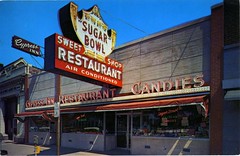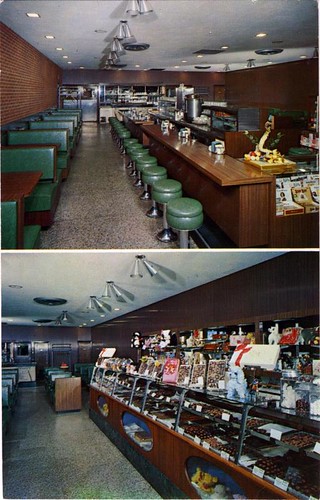 Des Plaines needs a new police station. This is not in dispute.
Des Plaines needs a new police station. This is not in dispute.The city has grown since the 1970s, and police services are much more extensive than they were at that time. The need is clear and is supported by independent outside studies. It is also clear that the current police station cannot be feasibly expanded to the necessary size, to fit all police services under one roof.
However, the city’s current approach to a new police station is completely wrong.
The current indications are that the city wants to level the entire block, build a new city hall at the corner of Miner and Lee, and a Public Safety complex adjacent to it. This is a bad idea on many grounds, among them environmental, city planning, financial, and historical.
From an environmental standpoint, the plan is a massive waste of resources. The buildings on the block comprise roughly 135,000 square feet of space, all of which would, evidently, be demolished under the current proposal. It would take a huge amount of energy to demolish all of this productive space, haul it to a landfill, prepare the site, and construct the new buildings – which would comprise roughly 120,000 square feet of space. Is it “green” to demolish a 32 year old city hall and replace it with a new one of equal size a few feet away?
The justification for a new city hall seems to be that the current one is lacking in meeting space and needs about one million dollars in repairs. It should be patently obvious that the new project will cost far more than one million dollars, so that issue can be dismissed. The current civic center cost $1.7 million – in 1977 dollars. As for the lack of meeting space, moving the police station to another site would free up that 20,000 square foot building as well as the 25,000 square feet within the city hall building – more than enough space to reconfigure for whatever new functions city hall needs. The solution is not a new building, but reworking what we already have. To call a 32 year old office building obsolete is absurd.
Downtown clearly has a traffic and parking problem. So why make the problem worse by packing the block with larger buildings and more staff? A police station uses a particularly large number of parking spaces because it has to provide parking for all those squad cars and other police vehicles. There is a good reason to get these cars out of downtown, and this is a good opportunity. This would open up more space for city hall parking within the block, which would in turn open up more parking elsewhere in downtown. Downtown is supposed to be a place people can go to spend money, not just a home for city services. This is why our 2007 city comprehensive plan does not designate the remainder of the block for public use.
This gets to perhaps the most powerful reason not to build here. The downtown tax increment financing district was put into place to provide for downtown revitalization. TIFs rely on increasing property values, generating more tax revenues to finance further improvements, which in turn should further increase property tax revenues. This project would act as a huge siphon on the downtown TIF. It not only relies on TIF funding for virtually the entire project, but takes productive real estate – some of the most valuable in the city - off the tax rolls by committing it to municipal use, which further hobbles downtown. This funding should be going to improving our downtown by making it more attractive. Anyone going through downtown can see that there is still work to be done; the historic buildings in downtown are in need of restoration. Instead, this project would be committing funds intended for improving downtown business to destroying them. The Choo Choo, the Masonic Temple Building, and the Svoboda Building contain many successful, long-established businesses and residents that contribute both sales taxes and property taxes. A new civic center would not generate any sales taxes, and would not increase property taxes; it would duplicate what is there while displacing existing generators. It would become a negative generator for the TIF, not only depleting the funds intended for improvement but decreasing the pool of property generating new funds. This is why the Illinois Tax Increment Allocation Redevelopment Act specifically prohibits the use of funds for
“constructing a new municipal public building principally used to provide offices, storage space, or conference facilities or vehicle storage, maintenance, or repair for administrative, public safety, or public works personnel and that is not intended to replace an existing public building (…) unless either (i) the construction of the new municipal building implements a redevelopment project that was included in a redevelopment plan that was adopted by the municipality prior to November 1, 1999 or (ii) the municipality makes a reasonable determination in the redevelopment plan, supported by information that provides the basis for that determination, that the new municipal building is required to meet an increase in the need for public safety purposes anticipated to result from the implementation of the redevelopment plan.”
The city’s argument attempts to utilize the caveats by arguing that development has necessitated a new police station. However, calls for a new police station did not come until 2001, and major downtown development in Metropolitan Square came afterward. It is clear that the city needed a new police station regardless of new development, and I find the argument that Metropolitan Square has required a major increase in police staff hard to believe. Additionally, the plan calls for the use of TIF funds to demolish two historic structures, the Choo Choo and Masonic Temple. The TIF act was recently amended to say that funds cannot be used to “demolish, remove, or substantially modify a historic resource, after the effective date of this amendatory Act of the 95th General Assembly, unless no prudent and feasible alternative exists.”
The Choo Choo is one of Des Plaines’ most unique, beloved, historic, and popular downtown attractions, drawing people from within Des Plaines and miles around. This is the sort of place most cities would kill to have in their downtowns. Even if the Choo Choo was allowed to stay, the surrounding construction and non-retail environment would be detrimental to its long term success. As a early international-style diner with excellent integrity and a unique business, the Choo Choo is very likely a contributing historic resource for a potential downtown historic district. The Masonic Temple building is another important contributor to a healthy downtown that has been ignored too long. It is not only one of the most architecturally distinguished buildings in the city, designed by prominent Chicago architect Clarence Hatzfeld, but has great potential to act as another big draw to downtown. It contains two large, beautiful, and underutilized halls that can be used for concerts, banquets, theatrical productions, meetings, conferences, and any number of other uses that will bring people downtown to spend money. In conjunction with a restored Des Plaines Theater, downtown Des Plaines can provide historic amenities that somewhere like Rosemont simply cannot. These two buildings are irreplaceable, and Des Plaines should consider itself lucky to have them, rather than rush to demolish them. Des Plaines needs to take advantage of its unique characteristics instead of seeking only chain stores and condominiums interchangeable with any community.
So what is the alternative?
I believe that the Littelfuse site is right for the police station. It is not only a large, well-located site, with ample room, but the existing buildings can likely be reused for the police. The sleek blue block and glass front is stylish, attractive, and has an image suitable for the police. It is a large, modern facility, and as a former factory has large, adaptable spaces. Reuse of an existing building will be far less expensive than building a new one, and would allow the police as much square footage as they desire. There are certainly other sites adjacent to, but not within downtown that could accommodate a station. If it must be within the block, perhaps the best plan would be to replace the Svoboda building and wrap around the Masonic Temple building, connecting the Temple to the Civic Center so that it may be used for meeting rooms and additional offices, as well as its current occupants.
In any event, TIF money should not be used for this project; if not because of the laws, because of the spirit of them. TIF is intended to revitalize an area, and should be used wisely, and for its intended purposes. It should be used to stimulate downtown through streetscaping, restoration of historic resources including facades, and overall creating an appealing, balanced, and integrated environment. Through these measures we can have a unique and healthy downtown.
The organization I belong to, Revitalize Des Plaines! exists to bring attention to these issues and others relating to improving Des Plaines through its historic resources. We encourage you to visit our blog at revitalizedesplaines.blogspot.com and join us or tell us what you think.
Sincerely,
Brian Wolf







